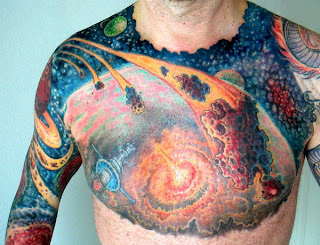I’ve been reading a book entitled “In the Flesh: The Cultural Politics of Body Modification” by Victoria Pitts to try and gain a better understanding of the mixed cultural significances of tattooing and body piercings, amongst an array of other forms of body modifications. Its easy to think of body modifications as existing on a spectrum of cultural acceptability; So that even though there has always been the presence of some form of body alteration in every culture.. Many forms are still seen as perverse and exotic.
“In all of these instances, the body is revealed as a space of important social significance. Body practices such as these show how the body figures prominently in our notions of self and community, in our cultural politics and in social control and power relations” (p.3).
I agree with this quote, what she is saying is that our initial impression of someone relies heavily on their aesthetic. This makes me wonder whether or not making assumptions based on visual cues is more than a social construct, but perhaps also a natural instinct. I know that in the animal kingdom mating relies heavily on attraction with body patterns. Natural selection ensures that undesirable genetic characteristics are bred out of the gene pool. Does this mean that tattoos are just a way to attract and obtain mates, or to repel predators (e.g. judgmental, close-minded people)?
No, I believe that body modification is more than biologically driven but is often a social and political statement as well. “Nonmainstream body modifiers create not only spectacle and controversy but also new forms of social rebellion through the body”(p.2). It can be an aesthetic statement as well. Many people get tattoos as a form of decoration; body modifications can often function as permanent jewelry and makeup. “I’ve noticed trends with [those] who are doing it purely for aesthetic reasons. To me it seems they look to the people who are actually doing it as still freaks and derelicts… The fashionization of some forms of body modification, such as nose, naval, and eyebrow piercings, and small tattoos, is apparent throughout popular culture.” (p.80).
These views on the meaning of tattoos and other body modifications imply that we have total controls over our image, which is not always the case. “The subcultural body is not made socially powerful only by its intended messages but also by the “spectator’s gaze” which views and makes sense of that body”. For example, I often get different reactions to my tattoos based on the part of the city that I am in. Riding the 4 train from Brooklyn to Uptown Manhattan means gazes of disapproval from business commuters and people from diverse ethnic communities that retain their own cultural morays and view my tattoos as unpleasant or impossible to understand.
https://blogger.googleusercontent.com/img/b/R29vZ2xl/AVvXsEhATuaIjez4uiYl7ozVZrCwxXx8_7WM3XQBI7LU5nqK7EwRhaJ2KlLlZt962p784Kuxkpk0yYzga_COjheDKvf-Ie4A3aObfX5L7y5sXMv3E8Dm1HhycjOwLbrGJvRUdlPBcNnvqiWugFw/s400/Mishu+%26+Santa+4.jpg
Considering all the different modes of expression that tattoos encompass, political, sexual, aesthetic, biological, deviance, and then the various cultural and societal lenses to be viewed, I think that tattoos are a continuously evolving art form that will adapt as society changes. This is captured perfectly by a quote from the book:
“These practices, at their most hard-core still highly deviant, undergo changes in meaning as the broader culture adapts to their presence on the cultural landscape" (p.80).
https://blogger.googleusercontent.com/img/b/R29vZ2xl/AVvXsEj6NdK3oUPjrn0hGp2cpG89uNToY0szOevN4BDOrOY4PU47_frdspfYuzaDQ0qSZ9vok8Y2hXcpUEQwlwOahNrdQ2H5p-JyPZmsskwfA2P2E4UrhksX7lcreCi14qdpfyeFSaKVRTOSQPFw/s1600/normal_face-tatoo.jpg
“The selves and bodies we construct in body projects are not ‘outside of power’, as Foucault famously puts it, but saturated with it… because body, gender, and other categories are seen as continually created in ongoing practices of embodiment they are de-essentialized, stripped of any “naturalness” or inevitability… this view affords the possibility of radicalism in body practice. Because the body-subject is socially constructed, it may be open to deconstruction and rewriting. Even though the body may be considered always already inscribed, it is never fully inscribed.”( p.40)
Quotes taken from: Pitts, Victoria. In the Flesh: The Cultural Politics of Body Modification. Gordonsville, VA, USA: Palgrave Macmillan, 2003. eBook.


















